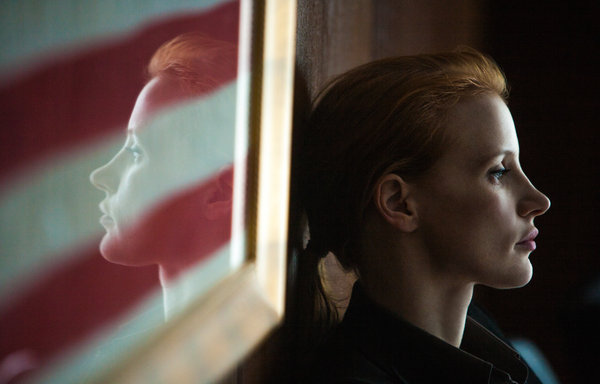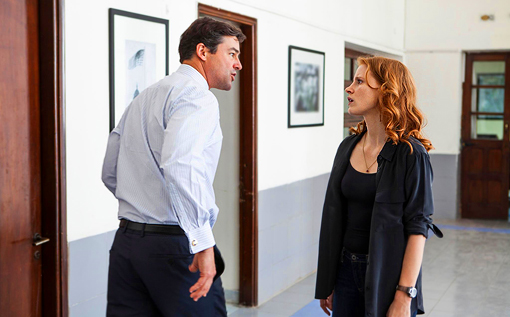★★★★
There comes a moment in Kathryn Bigelow’s Zero Dark Thirty where Maya (Jessica Chastain) figuratively shifts her gaze. It’s a crucial moment; one that guides the film–directionally–toward its intended purpose. When we first meet her she is docile, slightly squeamish, and, to a certain extent, hesitant. She is one of Washington’s top shelf CIA intelligence specialists–a woman refined, diligent and skilled. When faced with the task of tracking down the most wanted man in United States history, we assume that she has accepted her assignment with relative, but dutiful purpose. Said purpose, however, adamantly shifts to steadfast determination upon the sizing up of her prey: the stubbornly elusive Osama bin Laden, and, with eager anticipation, we become bystanders among Maya’s plight: the intensely purpose-driven task of finding, catching and killing the mastermind behind 2001’s darkest day.
Don’t be fooled, though. The films’ backdrop may be the decade long task of finding and eliminating “UBL,” but, this is Maya’s film. Zero Dark Thirty opens with a series of gut-wrenching interrogation scenes showing her as a passive, but inquisitive observer. She is shaken but not deplored. She is, at first, noticeably phased by her assignment. With this, Bigelow has made a key thematic decision: Maya becomes the lens through which we view the film, and, it’s from here that we watch the transformation of a skilled operative to that of the films’ headstrong, hopelessly determined hero.
We’re first introduced to Maya in a curiously conspicuous way. She enters the film suddenly and without a back story. At first, this plays as an off-putting decision, but, with time, we realize that it’s intentional, and, in a large way, essential to Bigelow’s intent. A high level operative such as Maya, by nature of her profession, is a woman of secrecy and personal information withheld. Any previous character development, given the story, would be a misstep.
From here, we go. Maya, assigned to track the whereabouts of Osama bin Laden, dives head first into a sea of intelligence bearing leads, detainees and countless piles of surveillance tape. Bigelow often regards her hunched over her desk, buried by droves of files and VHS tapes, her face sunken, her hand a kickstand for her weary head. Hampered by high-level bureaucracy, she sifts, elbows and engineers her way through bin Laden’s whereabouts via a hunch that, ultimately, with time and personal due diligence, pays off.
That hunch is Abu Ahmed al-Kuwaiti, the trusted courier of Osama bin Laden. Through years of diligent guesswork, analysis, knowing the right people and the seamless, skilled movements of her intelligence chess pieces, Maya finds her smoking gun: a direct link to the compound housing UBL. However hot it may in fact be, though, said gun doesn’t present itself as an unmitigated freebie. Throughout her nine year manhunt, she is aided and altered by a rigmarole of cataclysmic people and events, and, sometimes the combinations of both end in realities that bare the weight of heavier, more costly ramifications.
Take, for example, Maya’s colleague and confidant, Jessica. At Forward Operating Base Chapman, a key CIA facility in Afghanistan, she falls victim to a car bomb attack. This is a direct result of her decision to help Maya legitimize her goal. Hunting the country’s most wanted is a dangerous game indeed.
Through and through, Zero Dark Thirty remains a solidly engrossing political thriller. At times, the high-octane jargon on display in Mark Boal’s screenplay becomes tedious, but not in a way that toyed negatively with my attention span. With that said, though, these annoyances remain relatively moot when considering the bigger picture: Bigelow’s directorial choices and Boal’s writing are set pieces for a study of one woman’s eternal, unbending will, and how the enormity of her experience has altered her steel framed psyche.
Consider the last scene of the film. The raid on the compound has been successfully completed, and Maya gets personal proof that she’s thrown a bulls eye. It opens with the rear plank lowering on a military aircraft, revealing a giant, empty plane. Maya steps into it exhausted, consumed by its empty space. She exits the film just as she entered: alone, quiet and contemplative. The only difference here is that a decade has passed between these two Maya’s. By the end of the film, she has asserted her will, lost and regained hope, and now the only thing left to do, is cry. As we watch the final static shot of her face, her back against the interior wall of the plane, she does so, and, it is in this shot that we, along with Maya, reflect on the enormity of such an all-consuming undertaking.
Zero Dark Thirty is a very good film, but not a great one. Many critics and cinephiles have touted its “greatness” and are already considering it one of the decade’s best. I am not so sure of its greatness. Like Bigelow’s previous effort, the Academy Award winning The Hurt Locker–the study of a man who is seemingly impervious to combat-induced fear–Zero Dark Thirty is a highly functional character study that effectively utilizes the elements of a political thriller. The Hurt Locker, however, felt like a more complete film, and is, in my opinion, a great one.

